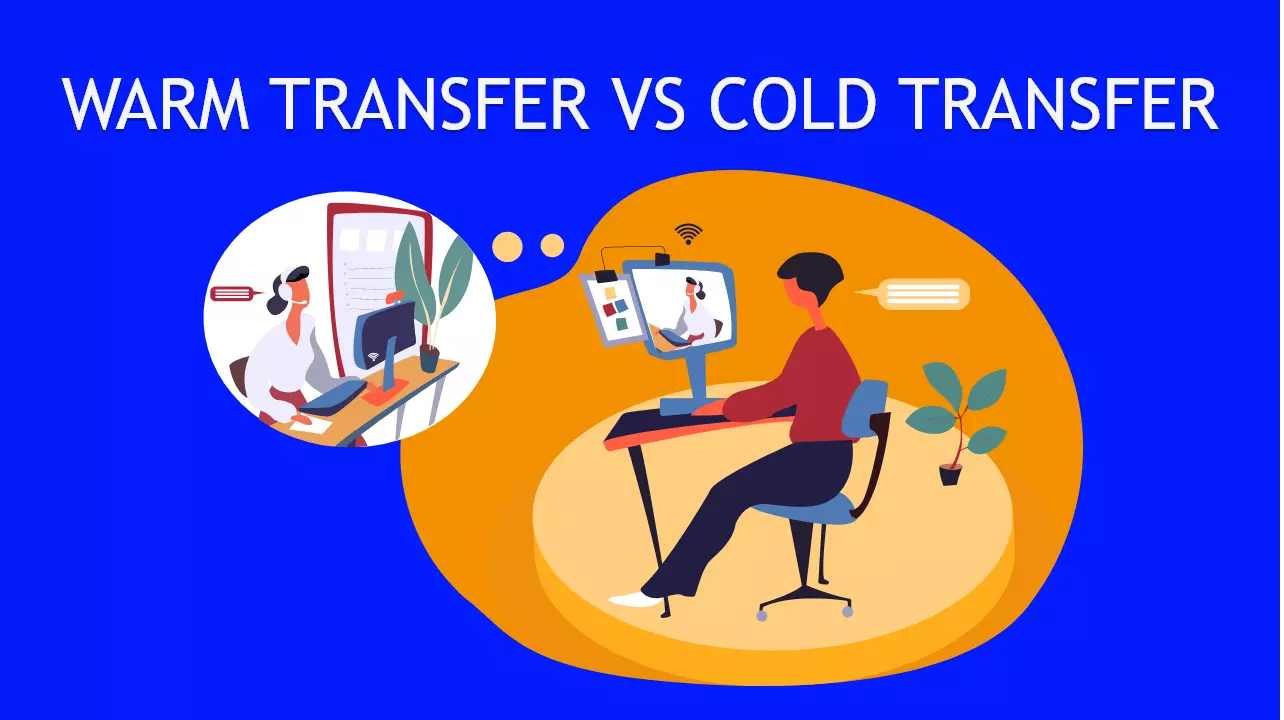Customer support calls are essential to create customer relationships and build a better brand reputation. Although resolving customers’ issues in the first Call is ideal, it is unavoidable for many businesses to avoid call transfers.
According to a recent report, 68% of customers get frustrated when agents transfer their Call to another agent. However, if call transfers resolve customer concerns, it will not create a negative customer experience. When done correctly, it will support your business.
If your business call center receives a large number of calls every day, the call center can help you in improving customer experience. Customer support agents must master the art of call transfer, learn the difference between warm vs. cold call transfer, and find when to use each one.
In this article, we will describe both types of call transfers and how your business can use them to provide a better customer experience.
What Is Call Transfer?
Call transfer is called forwarding, described as transferring a call from one user to another. Other names that describe this process include live transfer, soft transfer, consultative hold, or attended transfer.
This feature is available in advanced phone systems, which route calls to other destinations or voicemails. It is a more personal way to patch customer calls and help businesses create a positive customer experience.
However, all call transfers are not created equally; they have different impacts.
Types Of Call Transfer
There are two types of call transfer which are as follows:
- Cold Transfer: It is a process where a call is transferred to another agent without informing either the agent or the caller.
- Warm Transfer: It is a process where an agent receives the Call, greets the customer, puts it on hold for a few seconds, informs the other agent, and transfers the Call.
Now let’s explore these types of call transfers in detail to find which one is the best.
What is Cold Transfer?

The cold transfer is when an agent transfers a call to the other agent without informing them about the caller’s issue or briefing them with any details. It is also known as blind transfer, which usually starts through an automatic call distribution service.
Many businesses now use advanced methods to automate business processes, and automated call distribution is one of those methods. It means cold transfer usually does not start with human interaction. Instead, callers first interact with IVR systems that automatically transfer calls to agents.
One drawback of cold transfer is that it does not always create a relevant customer experience, and customers have to repeat themselves many times, which frustrates them. However, there are some situations where cold transfer is the best option.
Benefits Of Cold Transfer
Here are some benefits of cold transfer:
1. Time-Saving
Most call center agents prefer cold transfers because they are quick to initiate. It allows virtual receptionists to transfer calls to the appropriate agent.
For example, if a customer calls for any query and does not connect to the right agent, the call center software operator can transfer the Call quickly to the relevant team member.
2. Allows Immediate Response
According to a HubSpot report, 90% of customers say they require an immediate response when they reach a business and have a customer service question.
In another HubSpot report, 83% of consumers consider getting an immediate response to their sales or marketing questions crucial. In today’s fast-paced world, consumers are understandably impatient and seek relevant information immediately. Cold transfers play a vital role in achieving this goal.
The cold transfer option becomes handy when a caller reaches a different department. With this feature, agents can swiftly route calls to the appropriate department without any delay. It means customers do not have to wait or be put on hold, ensuring they receive the assistance they need promptly.
3. Transfer Call To the Right department
When customers call the wrong department, it can be frustrating for them and the associates or receptionist service agents trying to assist them. Thankfully, blind transfers come to the rescue in such situations.
Blind transfers are a fantastic option for associates and receptionists as they allow them to quickly redirect the Call to the right person or department without any delays. It ensures the caller gets the relevant information they need while boosting the agents’ productivity.
By efficiently cold transferring calls, associates can focus on helping customers find the right solutions, leading to happier customers and more effective customer service. It is a win-win situation that improves the overall experience for both callers and agents.
4. Streamline Heavy Workload
According to Shearer, cold transfer options are particularly handy during what’s known as an “all hands on deck” situation. It means when a contact center experiences a sudden surge of incoming calls and needs every available person to handle them promptly.
In such busy times, the priority is to serve all the customers efficiently and meet a specific deadline. Blind transfers come to the rescue as the fastest way to connect callers with agents who possess the relevant knowledge and expertise.
The cold transfer is a smart and effective approach to handling high call volumes and maintaining excellent customer service during hectic times.
When Should Businesses Use Cold Calling?
Businesses can use cold transfers in certain situations to handle specific call scenarios efficiently. Here are some instances when cold transfers are appropriate:
i. High Call Volumes
During peak hours or increased call traffic, cold transfers can quickly direct callers to the appropriate department or agent, reducing wait times and ensuring a faster resolution.
ii. Specialized Queries
When a customer has a specific or technical inquiry that requires the expertise of a particular team or agent, a cold transfer can efficiently connect them to the right person for a more accurate response.
iii. Time-Sensitive Calls
In situations where callers need to connect with agents quickly, such as emergencies or urgent customer issues, cold transfers allow callers to connect with available agents promptly without waiting for warm introductions.
IV. Overflow Scenarios
During busy periods when all available agents are occupied, cold transfers can redirect calls to other teams or departments that can handle them.
V. Multilingual Support
If a caller requires assistance in a different language, a cold transfer can connect them to an agent with the necessary language skills.
Vi. Routing to Experts
For complex or specialized cases, cold transfers can be used to reach subject matter experts who can provide the best solutions.
Vii. Direct Customer Requests
When a caller specifically requests to speak with a particular agent or department, a cold transfer can efficiently fulfill that request.
Warm Transfer

A warm transfer is when the agent receiving a call has full information about the customer. It is also called attended transfer or soft transfer.
In the warm transfer, a live agent attends the Call and transfers it to an agent who already has the customers’ details. This way, customers do not need to repeat themselves. The call agent with information about the customer can immediately greet the customer with a name and lead to the call resolution.
With this type of call transfer, customers feel valued and appreciated. With the warm transfer, you can welcome customers with a personal greeting instead of just saying a simple hello.
In warm call transfer, you may have to put customers on hold for a few seconds, so you must use on-hold music to keep customers engaged and happy.
Benefits Of Warm Transfer
As mentioned above, the warm transfer makes customers feel valued and more satisfied.
Let’s explore more benefits of this type of cold transfer so that you can use it to improve customer satisfaction.
It Notifies The Agent
In this type of call transfer, the virtual receptionist or live agent will notify the team member before transferring the Call to the new agent. In other words, we can say that the desired extension the customer asks for is informed before the call transfer.
In this process, the caller is put on hold when the operator connects the caller to the desired extension.
This type of transfer helps agents to learn about the issues of callers. Call transfer needs skills and tactics, and warm transfer offers them.
Streamline Agent's Situation
Warm transfers bring a different approach compared to cold transfers, especially when it comes to informing agents.
There is a clear difference when a user is connected to an agent with warm transfers. The user now has the power to decide whether they are available to answer the Call or prefer to have it sent to voicemail.
This simple but significant feature allows users to manage their time more efficiently. They can take the Call if available and ready to assist the caller. On the other hand, if they are occupied or unavailable, they can opt to send the Call to voicemail, ensuring that the caller’s needs are still addressed promptly.
Enhance Customer Experience
Customer satisfaction is at the heart of every successful contact center. And when it comes to achieving that, warm call transfers play a significant role.
Nothing can be more frustrating than being transferred without any context or information. Warm transfers solve this problem efficiently. Instead of suddenly passing the Call to another agent, the warm transfer allows a more personal touch.
With a warm transfer, the agent can personally greet the caller before fully connecting them to the right person. This simple act makes the caller feel valued and appreciated. It also gives team members the time and information they need to deliver top-notch customer service.
When Should Businesses Use Warm Transfer?
Businesses should use warm transfers when personalized and attentive customer service is crucial.
Here are some instances when warm transfers are highly beneficial:
1. Personalized Greetings
Warm transfers allow agents to greet callers with a warm and friendly welcome, making them feel valued and appreciated from the start of the conversation.
2. Customer Relationship Building
When a customer has an ongoing relationship with a specific agent, warm transfers ensure continuity and strengthen the bond between the customer and the business.
3. Detailed Context Sharing
With warm transfers, the initial agent can provide essential details about the caller’s issue, allowing the receiving agent to be well-informed and ready to assist seamlessly.
4. Complex Queries
For more intricate or delicate inquiries, warm transfers enable a smoother handoff, ensuring the customer doesn’t have to repeat themselves and receives the best possible assistance.
5. Reassurance and Professionalism
By personally introducing the caller to the next agent, warm transfers create a sense of reassurance and professionalism, enhancing the overall customer experience.
6. Building Trust
Warm transfers show that the business values the customer’s time and strives to provide personalized support, which helps build trust and loyalty.
7. VIP Customers
For high-value or VIP customers, warm transfers convey extra care and attention, making them feel like priority clients.
8. Smooth Escalations
When a call needs to be escalated to a higher-level agent or supervisor, warm transfers ensure a smooth transition without any disturbance.
9. Special Requests
If a caller asks to speak with a particular agent or expresses a preference, warm transfers fulfill their request and make them feel heard.
Cold Transfers vs. Warm Transfers, Which Is Better?
No one-size-fits-all choice between warm and cold transfers depends on the specific situation and customer preferences. Warm transfers are better for personalized service, relationship building, and handling complex inquiries. In contrast, cold transfers are more efficient during high call volumes, specialized routing, and time-sensitive situations. Both transfer types have strengths, so businesses should use them based on their unique needs to ensure excellent customer experiences.
Businesses should assess their specific customer service needs and objectives to determine which transfer type aligns better with their service strategy. In some cases, combining both transfer types might be the most effective approach to meet different customer needs and deliver outstanding customer experiences.
Conclusion - Cold Transfer Vs Warm Transfer
Both cold transfers and warm transfers have their place in providing excellent customer service. Businesses should carefully consider the specific circumstances of each Call and use the appropriate transfer type accordingly. Businesses can optimize their call transfer strategies and ultimately enhance the overall customer experience By understanding the unique needs of their customers and agents. Whether a warm transfer or a cold transfer, the goal remains to deliver exceptional service and build strong customer relationships that positively impact the brand’s reputation.




